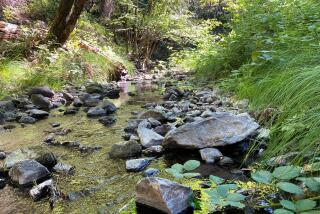More Water at Prado Dam Will Encroach on Songbirds : Habitat: Increased storage will save additional 434 million gallons of runoff, but will affect the endangered least Bell vireo, which nests close to the ground.
An agreement to raise water storage at Prado Dam one foot, thereby covering some of the habitat of an endangered songbird, was reached Thursday after water officials expressed concern that snowmelt was going out to sea.
“It is an emergency program,” said James A. Van Haun of the Orange County Water District, “because we are losing water to the ocean.”
The agreement by the water district, Army Corps of Engineers and the U.S. Fish and Wildlife Service allows the corps to raise a water conservation pool behind Prado Dam from 494 feet to 495 feet. That will save an additional 434 million gallons of water for gradual release into the water agency’s reservoirs in Anaheim, Van Haun said.
William R. Mills Jr., the district’s general manager, said the 434 million gallons of water is worth $225,000 and represents enough water to supply 3,000 Orange County families for a full year.
The involvement of the federal government was necessary because the action will affect the least Bell vireo, a small bird on the edge of extinction.
Prado Basin is the prime breeding ground for the five-inch, olive gray songbird, listed as an endangered species since 1986. The bird likes to nest near the ground, making the increase in the water level environmentally sensitive.
William Thomas, Army Corps of Engineers chief of reservoir operations, said that during California’s rainy season, the level behind Prado Dam is not restricted.
However, storm water must be released after March 15 of each year, the beginning of the nesting season for the vireos, if the level reaches 494 feet, Thomas said.
The least Bell vireo has traditionally caused a dilemma for water district officials. The district wants to conserve water, but by so doing encroaches on the bird’s habitat.
Last year, when the water district halted a proposed plan to release billions of gallons of storm water in the ocean, it guaranteed to pay at least $100,000 for monitoring the vireos, improving 30 to 50 acres of habitat and trapping cowbirds that prey on the rare species. The agency also agreed to pay $390,000 for preserving an old stagecoach stop behind the dam at the request of state archeologists.
Van Haun said mitigating factors for Thursday’s agreement included the monitoring program and the district’s planting of willows, where the vireos nest, on at least 124 acres. In addition, the birds have shown a strong, steady increase from 19 pairs in 1986 to 99 pairs in 1992.
“We reached the agreement because we have enough vegetation growing in the area, and the bird has been increasing in number,” Van Haun said.
“It’s warming up, the rains are over, and what’s been happening is, we have snowmelt from Big Bear Dam coming down, and we’re getting an abnormal flow in the (Santa Ana) River,” he said.
Van Haun said the cost to conserve the additional water is a small fraction of the cost to purchase imported supplies for restoring ground water storage to levels before the state’s six-year drought.
The water district, in compliance with the Endangered Species Act, has been working with the corps and with environmental agencies since 1989 on a plan to increase seasonal water storage elevation to 505 feet at Prado Dam.
More to Read
Sign up for Essential California
The most important California stories and recommendations in your inbox every morning.
You may occasionally receive promotional content from the Los Angeles Times.










